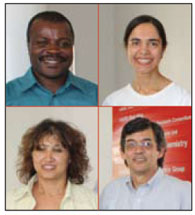Services on Demand
Article
Indicators
Related links
-
 Cited by Google
Cited by Google -
 Similars in Google
Similars in Google
Share
SAMJ: South African Medical Journal
On-line version ISSN 2078-5135
Print version ISSN 0256-9574
SAMJ, S. Afr. med. j. vol.99 n.5 Pretoria May. 2009
FROM THE EDITOR
Vaccines for Africa (VACFA) website – an innovative immunisation advocacy tool
Immunisation is the most cost-effective and successful public health intervention of all time, saving more than two million lives each year.1 There are currently more than 25 vaccine-preventable diseases, and the number of diseases that can be prevented by vaccines is growing as a result of advances in biomedical research, science and technology.
The introduction of immunisation programmes worldwide, following the initiation of the Expanded Programme on Immunisation (EPI) by the World Health Organization (WHO) in 1974, has resulted in significant accomplishments. In 1977 smallpox was eradicated after a 10-year campaign.1 Poliomyelitis will be the next disease in line to be eradicated. Since the Global Polio Eradication Initiative was launched in 1988, the incidence of poliomyelitis has decreased by more than 99% and about 5 million people have escaped paralysis by the wild poliovirus.1,2 In addition, the WHO estimates that measles deaths worldwide fell by a remarkable 74% between 2000 and 2007, from 750 000 to 197 000. It is estimated that during this period 11 million deaths were averted globally as a result of measles control activities.3 Furthermore, in 2007 global coverage for the third dose of the diphtheria-tetanus-pertussis combination vaccine was 81%, up from 20% in 1980.1
However, despite these tremendous advances, more than 24 million children still do not have access to basic immunisation services, including 7.3 million in sub-Saharan Africa.1 Those who miss out on routine vaccination programmes tend to be people living in remote locations, urban slums and border areas. Such hard-to-reach populations also include displaced populations, those lacking awareness or motivation to be vaccinated, and those who refuse to be vaccinated. The consequence of not having access to vaccines, or not being immunised, is the untimely death of 2 - 3 million people each year from vaccine-preventable diseases.1 A large proportion of these deaths occur in Africa.
Africa lags far behind other continents in the uptake of life-saving vaccines. Most children in Africa have access to only 6 - 8 vaccines. In contrast, a child born in a high-income country such as the USA has access to over 15 vaccines.4 This vaccine gap is widening by the day. There is an urgent need to reduce morbidity and mortality from vaccine-preventable diseases in Africa by increasing awareness of the benefits of vaccines, promoting the uptake of existing EPI vaccines, and advocating for the inclusion of new vaccines into national EPI programmes. In this regard, it is pleasing to note that the South African Health Department has introduced the rotavirus vaccine and the conjugated pneumococcal vaccine into the national EPI programme.
Effective communication should be an essential component of the EPI in Africa, because it could mobilise resources for national immunisation programmes, encourage wide participation and ownership of immunisation services among all stakeholders in every African country, and lead to positive changes in knowledge, behaviour and attitudes towards vaccines and immunisation in Africa.
These are the reasons why the Vaccines for Africa (VACFA) website (www.vacfa.com) was launched on 31 March 2009. The website is intended to be an interactive forum for the exchange of accurate, up-to-date and evidence-based information on vaccines and immunisation practices relevant to Africa. As such, it would be a 'one-stop shop' of targeted information for health professionals, policymakers, programme managers and the general public. VACFA complements the work of international immunisation advocacy organisations such as WHO, UNICEF, GAVI Alliance and other agencies in bringing relevant up-to-date information to decision makers in Africa in order to facilitate timely evidence-informed decisions.

Charles Shey Wiysonge
Zainab Waggie
Linda Rhoda
Gregory Hussey
School of Child and Adolescent
Health and
Institute of Infectious Disease and
Molecular Medicine
University of Cape Town
1. World Health Organization. WHO immunization work: 2006-2007 highlights. http://whqlibdoc.who.int/publications/2008/9789241596749_eng.pdf and http://www.who.int/immunization_monitoring/data/SlidesGlobalImmunization.pdf (accessed 7 April 2009). [ Links ]
2. World Health Organization. Progress towards interrupting wild poliovirus transmission worldwide, 2008. Wkly Epidemiol Rec 2009; 84: 109-116. [ Links ]
3. World Health Organization. Progress in global measles control and mortality reduction, 2000 - 2007. Wkly Epidemiol Rec 2008; 83: 441-448. [ Links ]
4. US Department of Health and Human Services. Recommended immunization schedule for persons aged 0 through 6 yrs – United States 2009. http://www.cdc.gov/vaccines/recs/schedules/downloads/child/2009/09_0-6yrs_schedule_pr.pdf (accessed 7 April 2009). [ Links ]














